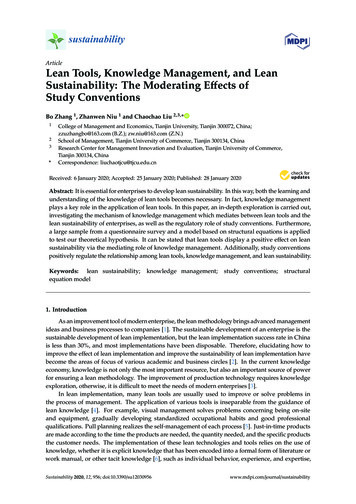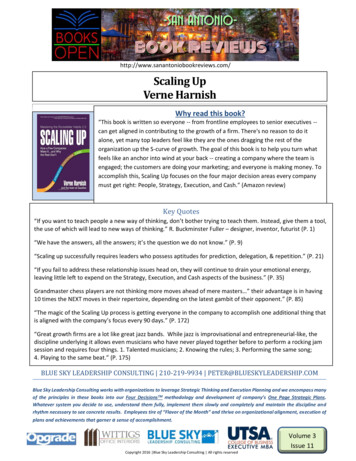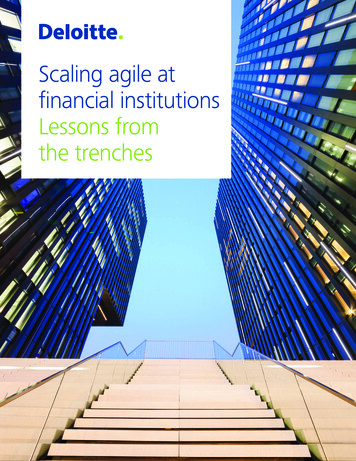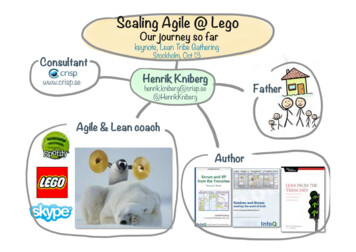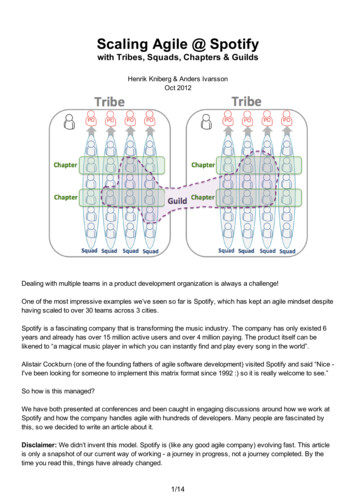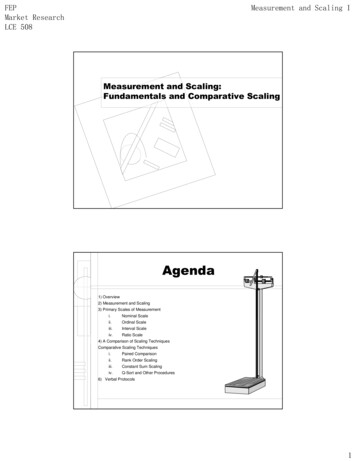
Transcription
SCALING LEANMastering the Key Metricsfor Startup GrowthAsh MauryaPortfolio / Penguin9781101980521 ScalingLean i-xii 1-292 2P.indd iii3/9/16 2:26 AM
PORTFOLIO / PENGUINAn imprint of Penguin Random House LLC375 Hudson StreetNew York, New York 10014penguin.comCopyright 2016 by Ash MauryaPenguin supports copyright. Copyright fuels creativity, encourages diverse voices, promotes freespeech, and creates a vibrant culture. Thank you for buying an authorized edition of this bookand for complying with copyright laws by not reproducing, scanning, or distributing any part ofit in any form without permission. You are supporting writers and allowing Penguin to continueto publish books for every reader.ISBN 9781101980521 (hardcover)\ISBN 9781101980538 (ebook)Printed in the United States of America10 9 8 7 6 5 4 3 2 1Set in Kepler Std Light with GeometricDesigned by Daniel Lagin9781101980521 ScalingLean i-xii 1-292 2P.indd iv3/9/16 2:26 AM
CONTENTSIntroduction: Another Book About Startup Growth?1PART 1DEFINING PROGRESSCHAPTER 121Traction Is the GoalCHAPTER 249The Back-of-the-Envelope Business Model TestCHAPTER 373Build a Traction Modelvii9781101980521 ScalingLean i-xii 1-292 2P.indd vii3/9/16 2:26 AM
PART 2PRIORITIZING WASTECHAPTER 4105The Customer Factory BlueprintCHAPTER 5129Benchmark Your Customer FactoryCHAPTER 6142Finding ConstraintsPART 3ACHIEVING BREAKTHROUGHCHAPTER 7163The Art of the ScientistCHAPTER 8189Seven Habits for Highly Effective ExperimentsCHAPTER 9214Dealing with FailureCHAPTER 10228Avoid the Curse of SpecializationviiiCONTENTS9781101980521 ScalingLean i-xii 1-292 2P.indd viii3/9/16 2:26 AM
CHAPTER 11258Hold Yourself CONTENTS9781101980521 ScalingLean i-xii 1-292 2P.indd ixix3/9/16 2:26 AM
INTRODUCTIONAnother Book AboutStartup Growth?ANOTHER BOOK ABOUT STARTUP GROWTH METRICS? WHY ADD TO ANalready crowded shelf?I have had the entrepreneurial bug my whole life. I came to the UnitedStates on a student visa which restricted me from starting a company. So I did thenext best thing. I joined a telecom startup shortly after graduating from university.After a few false product starts, that startup eventually found product/market fitwith a voice-over-IP softswitch product, which led to a successful exit in 2002. Thatis when I left to launch my first startup, WiredReach. Like the earlier startup, WiredReach began with a few false starts until I found product/market fit with a fi lesharing product targeted at small businesses. I subsequently sold that business in2010 to start my latest venture, LeanStack. Our mission is helping entrepreneurseverywhere succeed.My first book, Running Lean, grew out of the first set of challenges I experiencedas a startup founder: the need to quickly iterate from an early-stage idea (or plan A)into a plan that works. I had built many products over the years, and while they allstarted out equally exciting, not all of them stood the test of the market. I realizedthat I had many more ideas than I had time or resources to test them. More important, I didn’t have a repeatable process for doing so.19781101980521 ScalingLean i-xii 1-292 2P.indd 13/9/16 2:26 AM
Life’s too short to build somethingnobody wants.This prompted my search for the repeatable metaprocess I describe in Running Lean. It was derived from rigorous testing and firsthand experiential learning by buildingmany of my own products and by working alongside hundreds of other entrepreneurs spread across the globe in domains ranging from software to hardware andhigh-tech to no-tech businesses.The big epiphany for me while writing and researching Running Lean was thatthe true product of a successful entrepreneur is not just a great solution or an innovative piece of technology, but a repeatable process that connects your solution withpaying customers—in other words, finding a working business model.But it turns out that’s not enough. Running Lean, though it delivered on itspromise, described only the first step in a two-step process on the path to buildinga successful startup. Over time I found that when the time came to scale up myproducts and teams, my most rigorously tested business models faced a whole newset of challenges. I learned firsthand that seemingly watertight business models candisintegrate under the pressures of expanding into new markets and managingstakeholder expectations.I went searching for a solution.Scale Starts with MetricsBuilding a scalable and successful business starts with knowing what to measureand how.The first and most important stakeholder in the business is you, and your scarcest resource is time. Every minute spent on a business that is doomed to fail is awaste, and so it’s critical for you to be able to identify—quickly, early, and accurately—whether a business idea is worth pursuing.What’s more, you’re going to be called on to demonstrate progress to externalshareholders. From the earliest days of a startup’s life, you as a founder have to jus-2SCALING LEAN9781101980521 ScalingLean i-xii 1-292 2P.indd 23/9/16 2:26 AM
tify your new venture’s “potential for progress” to a VC,You are the first investor in yourCFO, spouse, or even yourself as a prerequisite to securingbusiness idea. You invest with time,runway.which is more valuable than money.Early-stage startups typically rely on two measures ofprogress: how much stuff they are building and how much money they are making.Yet unfortunately, both of these metrics are unreliable proxies of progress that canlead you down the wrong path—building something nobody wants.Traditional accounting metrics, like revenue, profit, and return on investment(ROI), aren’t helpful at the early stages because they all track numbers that are negative or near zero. Even at later stages, relying solely on aggregate revenue can prevent you from uncovering the right growth strategies.When my businesses were at this stage, I found myself wanting to collect andanalyze as much data as possible. But in a world where we can measure almostanything, it’s easy to drown in a sea of nonactionable data. I learned how to keepfrom drowning—and how to navigate the unfamiliar terrain that comes after Running Lean.The Wrong Way to Do ItThis book will teach you the metricsthat define a working businessmodel. Armed with these metrics,you can justify the investment ofyour time and communicateprogress with your internal andexternal stakeholders—withoutdrowning in a sea of numbers.Take a typical startup founder—let’s call him Bob. He hasa great idea for a business. This is the “honeymoon period”of his venture when anything seems possible. Bob believesit would be more effective to first build out his solution andmake it easier for others to see his vision. Halfway through,he realizes that he underestimated the scope of his solution and decides he needs to secure additional resourcesto continue.Bob spends the next several weeks writing a sixty-page business plan. He knowsthat the trick is starting with the right “exit number” and then working backward.A N O T H E R B O O K A B O U T S TA R T U P G R O W T H ?9781101980521 ScalingLean i-xii 1-292 2P.indd 333/9/16 2:26 AM
The right exit number represents the return on investment he needs to promise hisinvestors. This number needs to be big enough to whet their appetite, but also withinthe realm of believability to maximize his odds of getting funded. There is a running joke in business schools that the best spreadsheets get funded. So Bob laborsendlessly on his forecasts, often made up of hundreds of numbers. Then he hits thepitching circuit to raise funding for his idea.After several additional months of pitching and lots of rejection, he manages toraise just enough seed capital to move forward.Bob hires a team and spends the next several months tracking progress againstthe execution of his plan. Because revenue is nonexistent during this phase of theventure, Bob settles for measuring progress by ensuring that his team is building theirproduct on schedule and within budget.Fast-forward a year. Bob’s team has been very busy and managed to launchtheir product to market. But while they have some revenue to show, they have missedtheir projected targets—by a lot. Under pressure to demonstrate more promisingrevenue numbers to his stakeholders, Bob resorts to a number of short-term accounting tactics and product strategies, such as taking on custom development projects.These provide a temporary Band-Aid to the revenue problem, distracting him further from building a repeatable and scalable business model.Because all the money is now spent, Bob goes back to his stakeholders andattempts to pitch a brand-new vision that promises an even bigger exit. All he needsis a larger team and ten times more money.You know how this story ends, right? Bob is fired.Starting Right, Still Ending WrongMary too has an idea for a business, but she takes a “lean” approach to starting up.She knows that the top reason products fail is not a failure to build out the product,but rather a failure to build a repeatable and scalable business model.4SCALING LEAN9781101980521 ScalingLean i-xii 1-292 2P.indd 43/9/16 2:26 AM
She intends to navigate her entrepreneurial journey by following the three-stepmetaprocess outlined in Running Lean:BuildLearnDocument Plan AIdentify riskiest partsMeasureSystematically testyour planRather than spending weeks writing a full-fledged business plan or rushing tobuild out her solution, she quickly sketches her business model using a tool like theone-page Lean Canvas worksheet.* This lets her quickly deconstruct her vision and,better yet, capture her business model on a single page that she can share with otherpotential team members, advisers, and investors.She has valuable conversations about her business model, conversations thathelp her identify the riskiest assumptions in her thinking. She then gets outside thebuilding and begins stress testing her riskiest assumptions through a series of smalland fast experiments. Finally, Mary synthesizes everything she learns in order todefine the first iteration of her solution, or minimum viable product (MVP).Compared with Bob, Mary got started much faster. With the backing of earlycustomer validation, she is also on a more solid footing. Her early customer validation paves the way for securing additional resources from her stakeholders to moveforward. But that’s when her problems begin.* You can download a Lean Canvas worksheet at http://leanstack.com/lean-canvas.A N O T H E R B O O K A B O U T S TA R T U P G R O W T H ?9781101980521 ScalingLean i-xii 1-292 2P.indd 553/9/16 2:26 AM
Things get murkier, not clearer,after launch.While it was easy for Mary to pinpoint her starting risks,things get a lot murkier after her company launches its MVP. Hercompany is now signing up dozens of users a day, but conversionsto paying customers are well below projected targets. There is noway her team can talk to every user as Mary had done during the early days of thecompany. Her team decides to invest in metrics to understand what’s going wrong.Drowning in NumbersMary’s team starts off with a few simple off-the-shelf tools and supplements themwith their own homegrown dashboards. Pretty soon they are tracking thousands ofdifferent data points. Then they get that drowning feeling.“In God we trust. All others bringdata.”—W. EDWARDS DEMINGWTFWTF6SCALING LEAN9781101980521 ScalingLean i-xii 1-292 2P.indd 63/9/16 2:26 AM
The problem with metrics is that while they can tellyou what’s going wrong, they can’t tell you why.You don’t need lots of numbers,but a few key actionable metrics.Suboptimal ExperimentsMary’s team is simultaneously running all kinds of experiments. But despite usinga lot of jargon in their team meetings, like “hypotheses,” “learning,” and “pivots,” herteam is unable to change the fact that their sales numbers plot into a discouraging line.StartDisappointmentPivotRepeatResignationA N O T H E R B O O K A B O U T S TA R T U P G R O W T H ?9781101980521 ScalingLean i-xii 1-292 2P.indd 773/9/16 2:26 AM
While running experiments isa key activity in the Lean Canvasbusiness model, you have toknow how to design them forbreakthrough learning.The Curse of SpecializationMary intuits that she needs to slow down and refocus. She reorganizes her team into departments and assigns each one a set ofcore metrics tied to their performance and compensation structure. Her sales team is tracked on accounts closed, her marketing team on leads generated, and her development team on product quality metrics.This has an unintended effect. While these department-level key performanceindicators (KPIs) were designed to drive focus and optimize for overall organizational throughput, they started having the opposite effect. For instance, sales quotaswere typically met in the last week of the month. But while more deals were beingclosed, customer cancellations (or churn) started going up. The marketing team generated hundreds of additional leads by spending their entire budget, but the overallconversion to paying customers wasn’t going up. And developers were busier thanever building more features at an incredible pace. But customer retention and satisfaction were actually going down, not up. What was going on?Money TalksWhen all else fails, one can always fall back on revenue as a measure of progress,right? Not really.The problem with relying on revenue as a measure of progress is that revenue isgenerally a longer customer life-cycle event, which can mean having to fly blind fora really long time. Mary’s team was making huge bets on several big features. Eventhough her team called them experiments, these were three- to six-month-long initiatives with long build cycles. Her investors had no other option than to acceptthese product strategies on faith and wait to see what happened.8SCALING LEAN9781101980521 ScalingLean i-xii 1-292 2P.indd 83/9/16 2:26 AM
You need to shorten the feedback loop. Even whenA rising tide lifts all boats,revenue is realized, unless you can accurately tie it back tofalling tide lifts all fingers.specific actions or events from the past, it is easy to confuse correlation for causality. Mary’s teams didn’t knowwhat was causing what to happen.Whenever Mary’s company had a good quarter, everyone pointed to theirdepartment-level KPIs and took credit. During a bad quarter, the same teams woulduse the same KPIs to rationalize why the drop in revenue wasn’t their fault.The company’s initial momentum began to wear down and growth stagnated.It became increasingly difficult for Mary to justify the return on investment to herstakeholders.She too found herself spinning the numbers in board meetings. Her go-to measures of progress were either the amount of stuff her team was currently building(build velocity) or the amount of money they made that quarter (booked revenue)—depending on which was better.Eventually, she too was fired.but aIs There a Way Out?The mistake Bob made is that he spent a disproportionate amount of time focusingon a fictional business plan that he wasn’t able to realize.Mary had a much better early start, taking a “lean” approach. But despite herbest intentions, she found herself drowning in data—and anxiety—as she scaled upher product and team. Her team was looking at the wrong numbers, and these unreliable indicators of progress led them to prioritize the wrong actions, driving hercompany off course.To summarize, the traditional measures of progress are unhelpful for the followingreasons:A N O T H E R B O O K A B O U T S TA R T U P G R O W T H ?9781101980521 ScalingLean i-xii 1-292 2P.indd 993/9/16 2:26 AM
1. Because revenue is near zero during the early stages, we settle for build veloc-ity as a measure of progress. But measuring progress as execution of anuntested plan is no better.2. Investing heavily in quantitative metrics doesn’t automatically give you solutions. Metrics can tell you only what’s going wrong, not why. The more youinvest in quantitative metrics, the more you end up drowning in a sea of nonactionable data.3. Even when you are generating revenue, unless you can connect cause andeffect, you can’t leverage the elements that are bringing you success, and youcan easily be led down the wrong path.The Running Lean approach, like that of Eric Ries’s Lean Startup, is grounded inthe scientific method and thus sees validated learning as the measure of progress.However, most stakeholders regard business results, not validated learning, as themeasure of progress. So we end up building two different stories of our business.The story we tell our stakeholders is not the same as the story we tell ourselves.They both start out the same but diverge significantly over time because each usesa different definition of progress.Is there a way out of this dichotomy? That is the promise of this book.We Need a Single Measure of ProgressThe answer lies in first establishing a single metric of progress that both entrepreneurs and stakeholders can reliably use to measure business model success. Thatmetric is traction: the rate at which a business model captures monetizable valuefrom its users. We’ll expand upon this definition in chapter 1.Why isn’t the concept of validated learning enough to serve as a workable metric of progress? Validated learning is critical for testing key assumptions and invalu-10SCALING LEAN9781101980521 ScalingLean i-xii 1-292 2P.indd 103/9/16 2:26 AM
able for keeping our unbridled passion for our products inEstablishing a single measure ofcheck. But when this pursuit of learning is carried out atprogress around traction is key tothe expense of demonstrable business results, which isreconciling the dichotomy of multipleoften the case, the analogy of “a startup as an experiment”progress stories.breaks down. We need to realize that the goals of scientistsand entrepreneurs are not the same.The pursuit of raw knowledge is a scientific pursuit. In that realm, learning istruly the measure of progress. But entrepreneurship is goal driven. Empirical learning is part, but not all, of the final goal: to build a repeatable and scalable businessmodel before running out of resources.While empirical learning is a key part of that process, unless you can quicklyturn that learning into measurable business results, you are just accumulating trivia.Running ExperimentsIs Not EnoughWhy do so many lean practitioners get stuck running suboptimal experiments? Theanswer lies in how true science is done. What I learned surprised me:Running experiments is not considered the mostimportant thing scientists do.Can you guess what that is?Albert Einstein was one of the most celebrated scientists of the twentieth century. But he formulated the theory of relativity without running a single empirical experiment. In fact, while Einstein was a student at the Zurich PolytechnicA N O T H E R B O O K A B O U T S TA R T U P G R O W T H ?9781101980521 ScalingLean i-xii 1-292 2P.indd 11113/9/16 2:26 AM
Institute, he was advised by a professor there to get out of the profession because hewasn’t good at devising experiments.Einstein attributed his breakthrough insights not just to his mathematical andscientific prowess but to his simple mental models. These models were abstractedfrom the shapes and functions of everyday objects like trains, clocks, and elevators,and they helped him run hundreds of thought experiments. (You might remembersome of these from high school physics.)As I studied other scientists, I found the same repeating pattern:Scientists first build a model. Then they useexperiments to validate (or invalidate) their model.Entrepreneurs need models too. Running Lean introduced one such model, theLean Canvas, that can help you deconstruct a complex business idea into a businessmodel. Th is book introduces two additional complementary models: a tractionmodel and a customer factory model. They will show you how to effectively measureand communicate the output of a working business model.Waste Is EverywhereThe biggest contributor to suboptimal business results, though, is a lack of focus.Taiichi Ohno, the father of the Toyota Production System (which later becameLean Manufacturing), is known for drawing a chalk circle on the Toyota factoryfloor and having managers take turns standing in the circle. Not as punishment, butas an exercise in understanding and seeing waste through deliberate observation.“Waste is any human activity which absorbs resources but creates no value.”— JA MES P. WOM ACK AND DANIEL T. JONES, LEA N THINKING12SCALING LEAN9781101980521 ScalingLean i-xii 1-292 2P.indd 123/9/16 2:26 AM
Often a whole shift went by and the manager did not see what Ohno saw, becausefinding waste in an already efficient factory floor requires experience and effort. Oncethey began looking in the right places, they might for instance see that a machineoperator wastes time walking to the tool room to retrieve a component. This additional step could be eliminated simply by having these components closer at hand.These types of small improvements, when continually aggregated, yield largeresults in terms of overall improvement in productivity. However, when applied toinnovation, the problem isn’t one of finding waste, but rather prioritizing the biggestareas of waste. When operating in an environment riddled with extreme uncertainty and limited resources, it’s easy to find waste everywhere. The real challengeis identifying the few key actions that stand to deliver the greatest impact and ignoring the rest.Think of Ohno’s chalk circle exercise as a call to identify your riskiest assumptions. The problem is that uncovering what’s riskiest in your business model, whileconceptually easy to understand, is hard to put into practice.“The essence of strategy is choosing what not to do.”— MICHAEL PORTERIncorrect prioritization of risks is one of the top contributors to waste.Beyond some obvious initial starting risks like the assumptions you makeabout who your customers are and what problems they want to solve, risk prioritization requires good intuition and judgment, and it isn’t foolproof.So I went back in search of a better answer, this time to the world of manufacturing.A N O T H E R B O O K A B O U T S TA R T U P G R O W T H ?9781101980521 ScalingLean i-xii 1-292 2P.indd 13133/9/16 2:26 AM
Your Business Model as a SystemOne of the most groundbreaking books in the world of manufacturing was undoubtedly The Goal, the 1984 business novel by Israeli physicist Eliyahu Goldratt. Throughthe story of a struggling factory manager, Goldratt introduced the “theory of constraints,” a new way of thinking about production systems.Goldratt makes the case for visualizing the customer value stream not as onegiant process, but rather as a system of interconnected processes. You can internalize this concept by visualizing the customer value stream as links in a chain.At any given point in time, one of these links is going to be the weakest link orconstraint in the system. If we apply stress to this chain, the entire chain will not fallapart. It will break at its weakest link. Trying to reinforce all the links at once iswasteful because it will not make the chain stronger as a whole. This is the premature optimization trap.In other words, when we’re trying to improve any sort of production system, wederive the biggest return on effort only when we correctly identify and focus on theweakest link. What’s even more interesting is that as we strengthen this link andreapply stress to this chain, the weakest link moves to a different, and often unpredictable, link in the system.We can derive two further insights from this. The first is that reinforcing theweakest link will eventually yield zero returns, because another link will eventually14SCALING LEAN9781101980521 ScalingLean i-xii 1-292 2P.indd 143/9/16 2:26 AM
take its place as the constraint or the bottleneck, limiting the performance of theentire chain. The second takeaway is that because we cannot predict where the constraint will move, we need to constantly monitor the entire system in search of thenext weakest link. Blindly optimizing a single part of the system—even if it was oncethe weakest link—will eventually lead to waste. This is the local optimization trap.Our business models are no different. At the earliest stages of a business model,the weakest links typically live in your customer and problem assumptions. If thoseassumptions fall apart, everything else in your business model (your solution, channels, pricing, etc.) also falls apart. Focusing on anything else, like the scalability ofyour solution, is premature optimization. Beyond the earliest stages, no two products or entrepreneurs are the same. You can’t afford to simply guess at what’s riskiest. You need a systematic process for uncovering what’s riskiest.The divide-and-conquer approach at Mary’s company is a classic example offalling into the local optimization trap. Even though everyone was working tirelesslyto optimize their local metrics (local optima), it was at the expense of the overallsystem throughput (global optima). Her teams should have instead invested effortfirst toward identifying the weakest link or constraint in their business model, andthen collectively focused on solutions for breaking just that constraint.This book builds upon these concepts and marries systems thinking, The LeanStartup, and the scientific method to tackle the innovation challenges I outlined earlier. The next section describes how.How This Book Is OrganizedWhile Running Lean provided a tactical road map for stress testing a business modelthrough experiments, this book goes further. It extends the Lean Canvas businessmodel with additional models and thinking processes that help you make betterdecisions.A N O T H E R B O O K A B O U T S TA R T U P G R O W T H ?9781101980521 ScalingLean i-xii 1-292 2P.indd 15153/9/16 2:26 AM
Specifically, it teaches you how to effectively define, measure, and communicate progress with your internal and external stakeholders using the six-stepmetaframework shown below:GoalObserve and OrientLearn, Leverage, or LiftExperimentAnalyzeNext ActionsNote the mnemonic GO LEAN, which captures the first letter of each step inthis framework. This book is organized into three parts, in chronological order of thesteps required to apply this framework.PART 1: DEFINING PROGRESSPart 1 makes the case for using traction as the universal measure of progress (theGoal). It starts by defining traction and shows you how to turn fuzzy businessmodel goals into a more tangible metric that you can use to ballpark the viability ofany business model. Next you’ll learn how to break this ballpark goal into moreactionable milestones using a traction model.PART 2: PRIORITIZING WASTEPart 2 shows you how to benchmark your business model and apply techniquesfrom the theory of constraints to prioritize your riskiest assumptions or constraintsin your business model. This is the Observe and Orient step in the framework.PART 3: ACHIEVING BREAKTHROUGHPart 3 shows you how to use time-boxed LEAN sprints for breaking constraintsin your business model. Once a constraint is identified, you formulate a strategy16SCALING LEAN9781101980521 ScalingLean i-xii 1-292 2P.indd 163/9/16 2:26 AM
(or Validation Plan) for breaking this constraint by applying the three focusingsteps:1. Learn more about the constraint,2. Leverage the constraint, and3. Lift the constraint.You test these strategies using one or more small, fast, additive Experiments.Beyond validated learning, all experiments also need to be tied back to your overalltraction model. This is the Analyze step from which appropriate Next Actions aredetermined. Together, these make up the L-E-A-N steps in the sprint.How to Use This BookEach chapter ends with bulleted takeaways that summarizekey points. You’ll also find exercises along the way that guideyou in putting these principles into practice in your ownproduct.Let’s begin.No methodology can guaranteesuccess. But a good methodologycan provide a feedback loop forcontinual improvement andlearning.A N O T H E R B O O K A B O U T S TA R T U P G R O W T H ?9781101980521 ScalingLean i-xii 1-292 2P.indd 17173/9/16 2:26 AM
9781101980521 ScalingLean i-xii 1-292 2P.indd 183/9/16 2:26 AM
PART 1DEFINING PROGRESS“If you don’t know where you are going,any road will get you there.”— ADAPTED FROM ALICE IN WONDERL ANDGoalObserve and OrientLearn, Leverage, or LiftExperimentAnalyzeNext Actions9781101980521 ScalingLean i-xii 1-292 2P.indd 193/9/16 2:26 AM
9781101980521 ScalingLean i-xii 1-292 2P.indd 203/9/16 2:26 AM
CHAPTER 1Traction Is the GoalTHE FIRST MISTAKE WE M AKE WHEN WE PITCH OUR “GRE AT IDE A” TOstakeholders is that we lead with our solution. We spend a disproportionateamount of time talking about the uniqueness of our product’s features or itsunderlying technology breakthroughs. We can’t help it—we have the innovator’sbias for the solution.SolutionyouTheInnovator’sBiasnot you219781101980521 ScalingLean i-xii 1-292 2P.indd 213/9/16 2:26 AM
The solution is what we most clearly see and what gets us most excited. But ourstakeholders don’t necessarily see what we see. More important, their goals are different. They don’t care about our solution but rather about a business model storythat promises them a return on their investment within a set time frame.This is what they really want to know:1. How big is the market opportunity? They don’t care who your customers are,but how many—your market size.2. How will you make money? They want to understand the intersection of yourcost structure and revenue streams—your margins.3. And fi nally, they want to know how you will defend against copycats and competition that will inevitably enter the market if you are successful—your unfairadvantage.Let’s look at an example. Say you have invented a met
SCALING LEAN Mastering the Key Metrics for Startup Growth Ash Maurya Portfolio / Penguin 9781101


